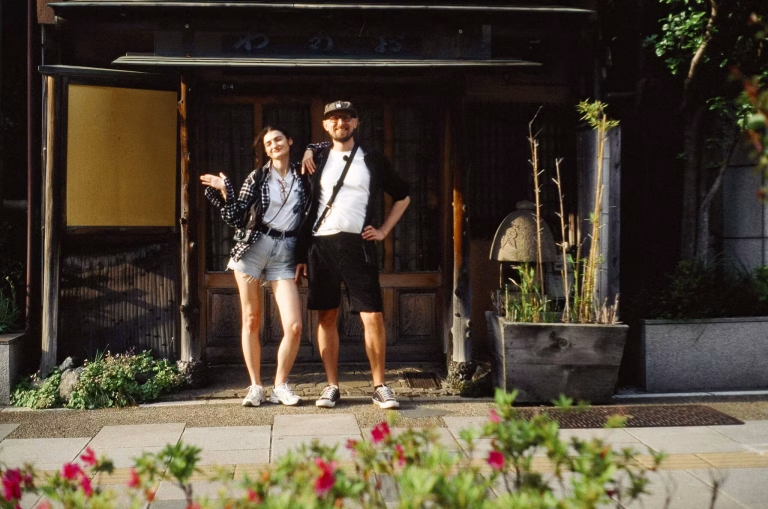In this post, you’ll discover my film photography scanning adventure — comparing Fuji Frontier and Noritsu film scanners versus manual editing of those same scans in Lightroom using the Negative Lab Pro plugin. All the photos you’ll see in this article are the resulting scans from:
- Fuji Frontier SP-3000
- Noritsu HS-1800
- My reprocessed scans using Negative Lab Pro from Noritsu scans
The difference might surprise you. Take a look at the photos and compare for yourself. In each group, the first photo is a Fuji Frontier scan, the second is from the Noritsu, and the third includes my manual tweaks ON TOP of the Noritsu scan — to expand the dynamic range and enhance the color.
Rediscovering Photography: From Digital to Film
Earlier this year, at the end of January, my girlfriend and I took a month-long trip to Chiang Mai. That’s when we decided to dive into film photography. We bought two film cameras—one each—and started shooting.
Before that, I had over a decade of experience with digital gear. My usual setup included the Fuji X-T4, Blackmagic Pocket 6K, and Canon 5D Mark III. Film felt like a return to something raw and slower. We were excited for that shift.
Getting Into Film Cameras in Chiang Mai
While in Chiang Mai, we discovered a great little shop on the outskirts of the city. It took us about 40 minutes to get there from Chiang Mai city center. The owner had a house full of vintage cameras — wall-to-wall nostalgia. I picked up a Pentax K2, and my girlfriend chose a Minolta AF-D.

First Experience with Film Photography Scanning on Fuji Frontier
During the next two weeks in Chiang Mai, we shot four rolls and found a local lab using a Fuji Frontier SP-3000 scanner. Scanning film photography was a completely new endevour for me. The first few rolls were from the Minolta—a point-and-shoot—so not quite the same depth as an SLR like the Pentax. But the scans were decent. Good enough resolution of 5444x3649px. We didn’t have anything to compare it to back then, so we were happy.
Later, when I started shooting with the Pentax and sending scans to the same lab, I noticed a lack of fine detail. Nothing terrible—but not quite what I expected either.

Japan Trip and 9 More Rolls of Film
In the late April 2025 we took a 12-day trip to Japan—Tokyo, Kyoto, Nara. We shot nine rolls on that trip, using a mix of color reversal and negative films: Ektachrome E100, Marix D100, Fuji 200, Fuji 400, Ilford Delta, CineStill 50D, and Kodak ColorPlus 200.






On our way back from Japan to Thailand we had the undeveloped rolls hand-checked at the airport to avoid X-ray damage, and I took the undeveloped rolls to another lab in Bangkok—this one uses the Noritsu HS-1800 scanner. The color difference was night and day.
Fuji Frontier vs Noritsu: A Film Photography Scanning Comparison
The results? Impressive. Much higher resolution—around 6500px on the long side. Richer color, too. Closer to what I remembered seeing with my own eyes. I have a lot of examples in my portfolio, so you can see the quality.
But it wasn’t perfect. Noritsu scans had their own quirks: heavy contrast, crushed blacks, and sometimes odd color shifts. So I started comparing. Some images looked better on the Fuji Frontier, others on the Noritsu.
I wasn’t satisfied. I wanted more control.
Discovering Valoi & Negative Lab Pro for Better Film Scans
That’s when I found Valoi—a company from Finland that makes home film scanning tools. They had these devices like the Valoi easy35 and Valoi easy120, paired with DSLR scanning and post-processing in Lightroom using a plugin called Negative Lab Pro.
I didn’t own the Valoi gear, but I decided to test their workflow anyway—just using my existing JPEG scans. Not ideal (8-bit, compressed, contrast already baked in), but I gave it a shot.
Surprisingly, it worked. I recovered shadows, improved tones, and got colors that felt much more alive. Still far from perfect, but way better than what I started with.
Planning for Medium Format and Home Film Photography Scanning
In Japan, I also picked up a Rolleiflex 3.5F and shot a few rolls of medium format. I managed to scan only one roll of BW film from Rolleiflex with Noritsu scanner but am planning to test them on the Valoi 120.
Once I get my hands on it, I’ll re-scan everything. The good part is that Valoi 120 has the 35mm adapter so it is possible to scan both 120 and 135 format film. There’s so much detail in film that labs often lose or compress.
At some point, I plan to get the Valoi 120 and do a full hands-on review. I imagine the raw DSLR scans, processed in Lightroom with Negative Lab Pro, will offer even more flexibility—especially for recovering shadows and dialing in color exactly the way I want it.
Until then, I’m continuing to refine my workflow and enjoy the process of learning film all over again.
Welcome to the art of slowing down.


Fascinating story, Ustin! Thanks for sharing.